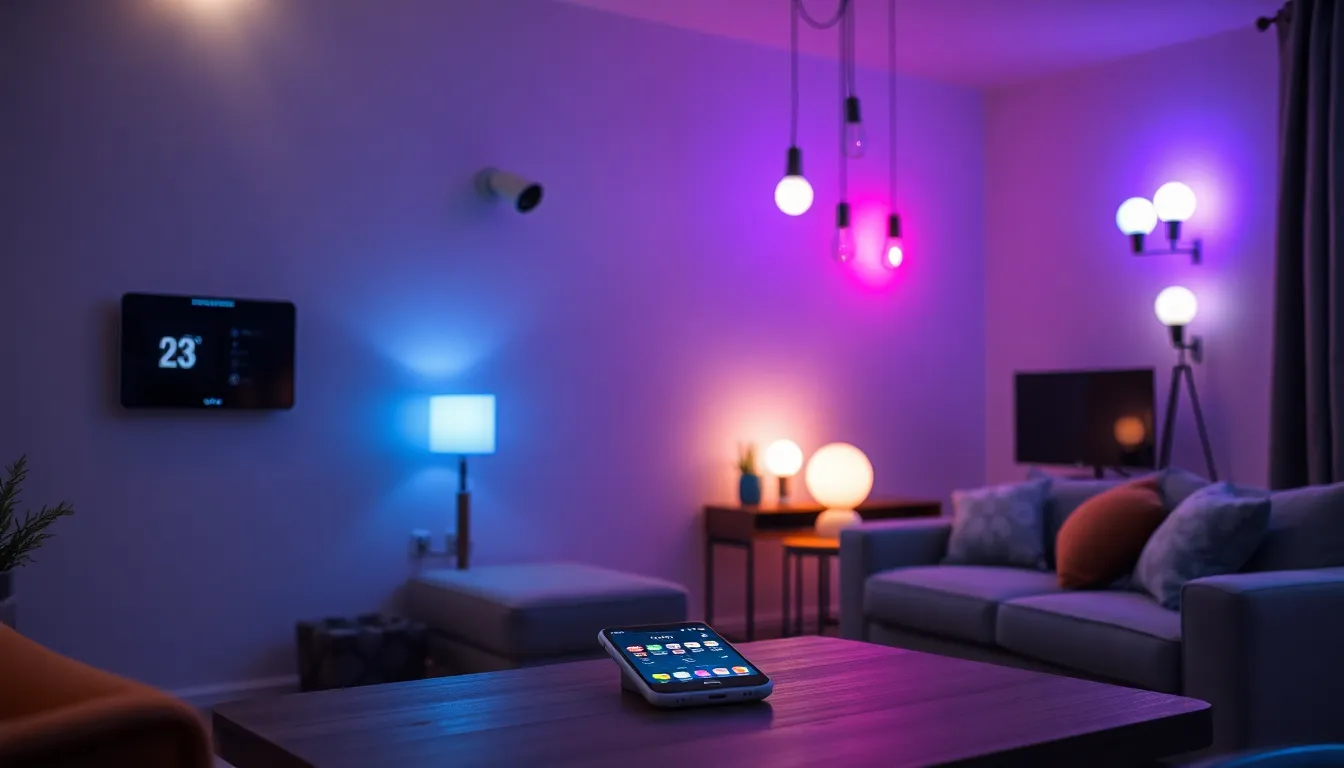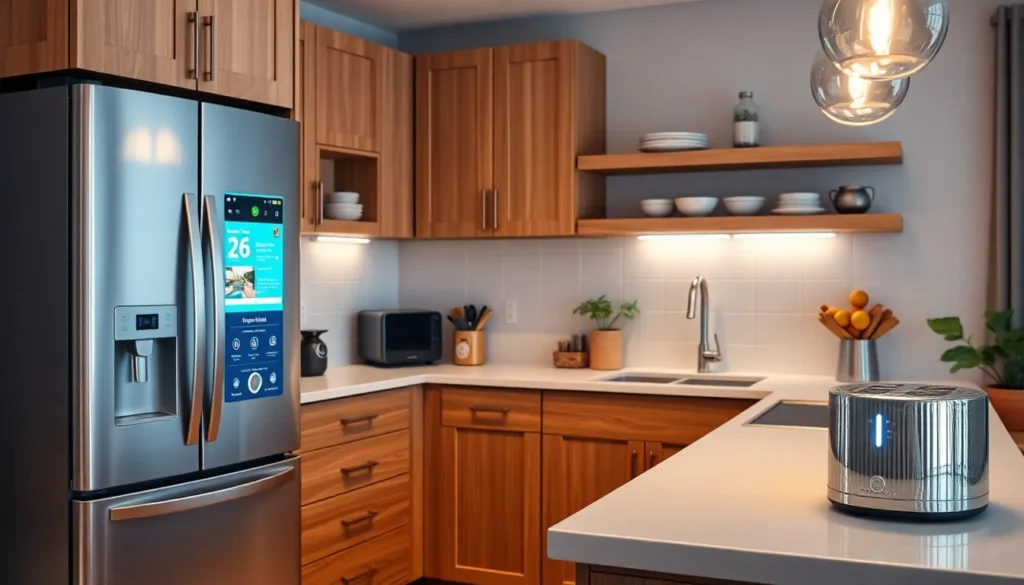Table of Contents
ToggleIn a world where even toasters can connect to the internet, smart hardware is taking center stage. Gone are the days of simple gadgets; now, everything from your fridge to your light bulbs is getting a brain upgrade. Imagine a home that anticipates your needs before you even have to lift a finger. Sounds like science fiction? Welcome to the future!
Overview of Smart Hardware
Smart hardware refers to everyday devices equipped with advanced technology to enhance functionality. These connected devices, found in modern homes, include appliances like refrigerators, ovens, and security systems. Each item typically integrates with Wi-Fi, enabling remote control and monitoring.
User experience improves significantly through automation. For instance, smart thermostats learn users’ preferences to adjust temperature settings efficiently. Similarly, smart lighting systems allow individuals to control brightness through smartphones or voice commands.
Data collection plays a crucial role in smart hardware functionality. Devices gather information about user habits to provide tailored recommendations. For example, some refrigerators track inventory and suggest grocery shopping lists based on current contents.
Interoperability among smart gadgets enhances their effectiveness. A smart security system can link with door locks and cameras, enabling comprehensive monitoring of the home environment. Additionally, the convenience of reaching controls via mobile apps or voice-activated assistants ensures easy interaction.
Safety and energy efficiency often greatly improve with smart hardware implementation. Many smart devices incorporate features that allow users to identify potential hazards or reduce energy consumption. Smart plugs and power strips, for example, can monitor electricity usage and schedule power to devices accordingly.
This ongoing trend towards automation and connectivity signifies a cultural shift in how households operate. As technology continues to evolve, smart hardware will likely become the standard, leading to more intuitive and sustainable living environments.
Key Features of Smart Hardware

Smart hardware enhances everyday living through innovative technologies. It offers various functionalities that cater to user preferences and needs.
Connectivity Options
Smart hardware operates primarily through versatile connectivity options. Devices connect via Wi-Fi, making remote access effortless. Bluetooth enables quick interactions without relying on the internet. Zigbee and Z-Wave protocols facilitate communication across smart home ecosystems. Users can control appliances from smartphones or voice assistants, ensuring convenience. Automation features such as scheduled tasks streamline daily routines. Each connectivity option supports seamless interaction among devices, enhancing user experience.
Integration with IoT
Integration with the Internet of Things (IoT) amplifies the capabilities of smart hardware. This technology allows devices to communicate and collaborate efficiently. Sensors collect real-time data on user behaviors and preferences. Data analysis leads to tailored recommendations, improving efficiency and personalization. Home security systems, temperature controls, and lighting adapt based on user input. IoT integration fosters a cohesive smart home environment, ensuring a harmonious and intuitive living space. Interconnected devices yield comprehensive control, contributing to energy savings and enhancing safety through constant monitoring.
Benefits of Smart Hardware
Smart hardware offers significant advantages in modern living, focusing on efficiency and user experience. Its ability to adapt and respond to daily needs transforms everyday tasks.
Enhanced Efficiency
Smart hardware boosts energy efficiency in several ways. Smart thermostats learn heating and cooling patterns to optimize usage based on user behavior. Appliances like smart fridges monitor food inventory, reducing waste through timely reminders. Moreover, smart plugs track energy consumption, enabling better management of electricity use. These features contribute to lower utility bills and a reduced carbon footprint. Devices communicate seamlessly, enhancing overall system performance and making life simpler for users.
Improved User Experience
The user experience becomes remarkably enhanced with smart hardware. Personalized settings adjust automatically, catering to individual preferences and habits. Control via smartphones allows easy access to devices from anywhere, creating a more flexible lifestyle. Voice commands further simplify engagement, enabling users to execute tasks effortlessly. Real-time feedback from smart devices fosters a sense of connection and awareness, enriching daily interactions. Altogether, these innovations create a harmonious environment that anticipates and responds to needs, ensuring convenience and comfort in every aspect of life.
Challenges and Limitations
Smart hardware brings challenges that can hinder its widespread adoption.
Security Concerns
Security risks pose a significant issue for smart hardware. Numerous devices connect to the internet, making them vulnerable to hacking attempts. Hackers can exploit weaknesses in security protocols and access sensitive information, such as personal data and home security systems. Strong encryption and robust authentication measures can help mitigate these risks, but many users overlook software updates that patch crucial vulnerabilities. Additionally, smart devices often lack stringent security guidelines, increasing the likelihood of breaches. As manufacturers prioritize convenience, compromises in security may occur, leading to potential privacy invasions.
Compatibility Issues
Compatibility presents another major challenge. Many smart devices use varying protocols and standards, leading to communication difficulties between gadgets. Not every product can seamlessly integrate with others, causing frustration for users aiming for a cohesive smart home experience. Users frequently encounter issues when trying to connect devices from different brands, as compatibility varies widely. A lack of universal standards exacerbates these problems, forcing consumers to choose products based solely on interoperability. These barriers can limit the overall effectiveness and convenience of smart hardware ecosystems.
Future Trends in Smart Hardware
Emerging technologies define the future of smart hardware, with advancements in artificial intelligence and machine learning leading the way. Seamless integration into daily life becomes a norm as devices become more intuitive and responsive to user needs. Voice-activated systems are evolving to understand complex commands, significantly enhancing user interaction. Increased reliance on automation streamlines household tasks, reducing the need for manual input.
Connectivity enhancements are also on the rise. Adoption of 5G networks provides faster data transmission, enabling real-time communication between devices. As a result, smart appliances can respond almost instantly to user commands, elevating convenience. The development of energy-efficient technologies contributes to substantial cost savings and a decreased environmental impact.
Interoperability remains a crucial focus. Devices from different manufacturers increasingly communicate through unified platforms, creating cohesive smart home ecosystems. Integration with popular virtual assistants enhances user experience, allowing control of various devices through a single interface. Comprehensive security measures are becoming standard, addressing earlier concerns related to data protection.
Furthermore, data analytics plays a significant role in personalizing user experiences. Smart hardware is equipped to analyze user behavior, offering tailored suggestions that enhance efficiency and comfort. Predictive maintenance alerts for appliances improve longevity, reducing unexpected failures and maintenance costs.
Users demonstrate growing interest in security-focused hardware. Technologies such as smart locks and monitoring cameras are prioritizing safety and accessibility, ensuring homes remain secure. Continuous advancements in smart hardware create opportunities for more intelligent, efficient, and sustainable living environments as technology evolves.
The evolution of smart hardware is redefining how individuals interact with their living spaces. As these devices continue to integrate advanced technologies and automation, they promise a future where homes operate more intuitively and efficiently. The benefits of enhanced energy management and personalized experiences are undeniable.
However, challenges such as security vulnerabilities and compatibility issues remain significant hurdles. Addressing these concerns will be crucial for widespread adoption and user confidence. As advancements in artificial intelligence and connectivity unfold, the potential for smart hardware to create safer and more sustainable living environments is exciting. The journey towards a fully connected home is just beginning, and its impact will be felt for generations to come.




